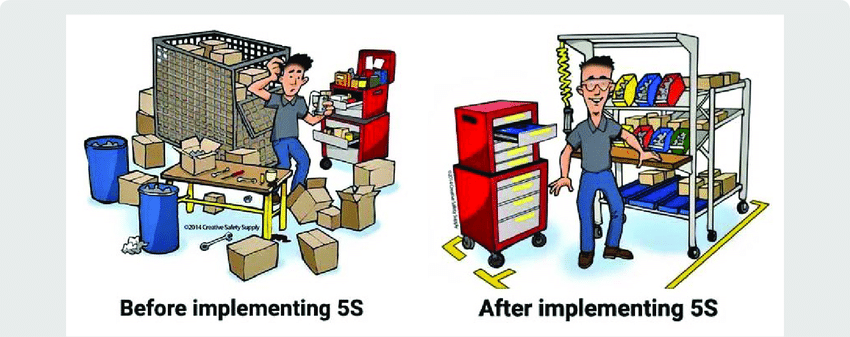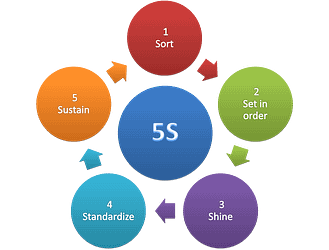In today’s fast-paced business world, companies must constantly look for ways to improve their productivity and efficiency while reducing waste. One method that has gained popularity in recent years is the 5S methodology, a Japanese concept aimed at streamlining processes and eliminating waste. In this article, we will delve into the basics of the 5S methodology, its benefits, and how it can be implemented in a business setting.
Table of Contents
- Introduction to the 5S Methodology:
- The Five S’s:
- Sort
- Set in Order
- Shine
- Standardize
- Sustain
- Benefits of Implementing 5S:
- How to Implement the 5S Methodology?
- Step 1: Get Management Buy-In
- Step 2: Conduct a Current State Analysis
- Step 3: Develop a Plan
- Step 4: Train Employees
- Step 5: Implement the Plan
- Step 6: Monitor and Sustain
- Real-World Examples of 5S Implementation:
- Common Mistakes to Avoid:
- Conclusion:
- FAQs:
Introduction to the 5S Methodology:
The 5S methodology is a lean manufacturing tool that originated in Japan. It was developed as a part of the Toyota Production System in the 1960s and later became popular among other Japanese manufacturing companies. The concept behind 5S is to create a work environment that is clean, organized, and efficient. The methodology focuses on five key areas, each beginning with the letter “S” in Japanese, which makes it easier to remember and implement. The five S’s are Sort, Set in Order, Shine, Standardize, and Sustain.
The Five S’s:
I. Sort:
The first step in implementing the 5S methodology is to sort through all of the items in the work area and separate them into three categories: keep, discard, and undecided. Items that are necessary for the work process should be kept, while unnecessary items should be discarded. Undecided items should be carefully evaluated to determine whether they are truly necessary for the work process.
II. Set in Order:
After the sorting process, the next step is to arrange the necessary items in a way that is organized and efficient. This involves determining the optimal location for each item and labeling everything clearly so that it can be easily found and used. The goal of this step is to eliminate wasted time searching for tools and materials.
III. Shine:
The third step of the 5S methodology is to clean and inspect the work area thoroughly. This includes cleaning all surfaces, tools, and equipment and ensuring that everything is in good working condition. The goal of this step is to create a safe and healthy work environment that is free of hazards and distractions.
IV. Standardize:
Once the work area has been sorted, organized, and cleaned, the next step is to standardize the process. This involves creating standard operating procedures for all aspects of the work process, from how tools are used to how materials are handled. The goal of this step is to create a consistent and reliable process that can be repeated consistently over time.
V. Sustain:
The final step in the 5S methodology is to sustain the improvements that have been made. This involves developing a system for ongoing maintenance and continuous improvement. The goal of this step is to ensure that the improvements are sustainable and that the work area remains clean, organized, and efficient over time.
Benefits of Implementing 5S:
There are many benefits to implementing the 5S methodology in a business setting. These include:
I: Increased efficiency and productivity.
II: Reduced waste and costs.
III: Improved safety and quality.
IV: Enhanced employee morale and engagement.
V: Better use of space and resources.
By streamlining processes and eliminating unnecessary items and steps, the 5S methodology can help businesses save time and money while improving the quality of their products and services. It also creates a safer and more enjoyable work environment, which can lead to increased employee satisfaction and productivity.
How to Implement the 5S Methodology?
Implementing the 5S methodology requires a systematic approach that involves all employees in the organization. Here are the steps involved:
Step 1: Get Management Buy-In:
Before starting the implementation process, it’s essential to get buy-in from top management. This involves explaining the benefits of the 5S methodology and how it can help the organization achieve its goals. It’s also important to establish a clear vision and set of objectives for the implementation process.
Step 2: Conduct a Current State Analysis:
The next step is to conduct a current state analysis of the work area. This involves analyzing the work process, identifying areas of waste, and documenting the current state of the work area. This information can then be used to develop an improvement plan.
Step 3: Develop a Plan:
Based on the results of the current state analysis, a plan should be developed for implementing the 5S methodology. This plan should include specific goals, a timeline, and a budget. It should also outline the roles and responsibilities of each employee involved in the implementation process.
Step 4: Train Employees:
Once the plan has been developed, it’s important to train all employees on the 5S methodology and how it will be implemented. This training should include information on the five S’s, as well as how to identify and eliminate waste.
Step 5: Implement the Plan:
The next step is to implement the plan. This involves sorting through all items in the work area, setting them in order, cleaning and inspecting the area, standardizing the process, and sustaining the improvements that have been made.
Step 6: Monitor and Sustain:
Finally, it’s important to monitor the improvements that have been made and sustain the changes over time. This involves developing a system for ongoing maintenance and continuous improvement, as well as regularly reviewing and updating the 5S process as needed.
Real-World Examples of 5S Implementation:
The 5S methodology has been successfully implemented in many different types of businesses, from manufacturing and healthcare to retail and hospitality. For example, a hospital in California implemented the 5S methodology in its surgical department, resulting in a 50% reduction in surgical site infections and a 40% reduction in surgical delays. A manufacturer in Michigan implemented the 5S methodology in its assembly line, resulting in a 25% increase in productivity and a 60% reduction in defects.
Common Mistakes to Avoid:
When implementing the 5S methodology, there are several common mistakes that businesses should avoid. These include:
I: Failing to get buy-in from top management
II: Neglecting to involve all employees in the process
III: Overcomplicating the process
IV: Failing to sustain the improvements over time
By avoiding these mistakes and following the 5S methodology systematically, businesses can achieve significant improvements in productivity and efficiency.
Your feedback matters! Please let me know how I did with a thumbs up!
Conclusion:
In conclusion, the 5S methodology is a powerful tool for improving efficiency, reducing waste, and enhancing the overall work environment. By following the five S’s – Sort, Set in Order, Shine, Standardize, and Sustain – businesses can create a more organized, productive, and enjoyable work environment. By getting buy-in from top management, involving all employees in the process, and avoiding common mistakes, businesses can successfully implement the 5S methodology and reap its many benefits. By doing so, businesses can improve safety, quality, and employee engagement, while reducing costs and improving their bottom line.
FAQs:
Q. What does 5S stand for?
A. 5S stands for Sort, Set in Order, Shine, Standardize, and Sustain.
Q. How can the 5S methodology help my business?
A. The 5S methodology can help businesses improve efficiency, reduce waste, enhance safety and quality, and boost employee morale and engagement.
Q. What are some common mistakes to avoid when implementing the 5S methodology?
A. Common mistakes to avoid include failing to get buy-in from top management, neglecting to involve all employees in the process, overcomplicating the process, and failing to sustain improvements over time.
Q. Can the 5S methodology be applied to any type of business?
A. Yes, the 5S methodology can be applied to any type of business, from manufacturing and healthcare to retail and hospitality.
Q. What is 5S and why is it used?
A. 5S is a workplace organization method that involves creating and maintaining a clean, organized, and efficient work environment. It is used to increase productivity, reduce waste, and improve safety and quality.


I would like to thnkx for the efforts you have put in writing this site. I’m hoping the same high-grade blog post from you in the upcoming as well. In fact your creative writing abilities has inspired me to get my own web site now. Really the blogging is spreading its wings quickly. Your write up is a good example of it.
I抦 now not positive the place you’re getting your information, however good topic. I needs to spend a while learning more or figuring out more. Thank you for great information I was in search of this info for my mission.
yandanxvurulmus.I8hRedGvg0vs